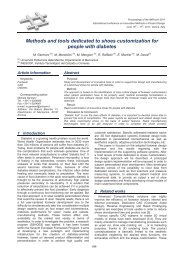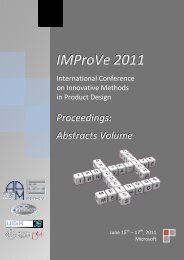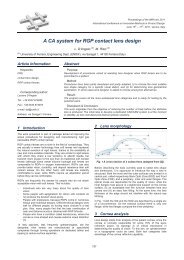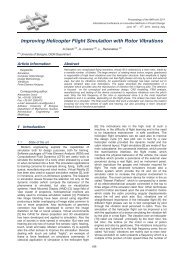IMProVe 2011 - Proceedings
IMProVe 2011 - Proceedings
IMProVe 2011 - Proceedings
You also want an ePaper? Increase the reach of your titles
YUMPU automatically turns print PDFs into web optimized ePapers that Google loves.
Engineering Methods in Medicine<br />
Analysis and design of a thrombectomy device<br />
by using simulation techniques<br />
G. Romero (a), M. L. Martinez (a), J. Felez (a), G. Pearce (b), G. Romero (a), M. L. Martinez (a), J. Felez<br />
(a), G. Pearce (b), N. D. Perkinson (c)<br />
(a) ETS Industrial Engineering, Universidad Politecnica de Madrid. Spain<br />
(b) Wolverhampton University. United Kingdom.<br />
(c) Whatangamata, Waikato. New Zealand.<br />
Abstract:<br />
Purpose:<br />
In this work, we present the analysis, design and optimization of one experimental device<br />
recently developed in the UK, called the 'GP' Thrombus Aspiration Device (GPTAD). This<br />
device has been designed to remove blood clots without the need to make contact with<br />
the clot itself thereby potentially reducing the risk of problems such as downstream<br />
embolisation.<br />
Method:<br />
To obtain the minimum pressure necessary to extract the clot and to optimize the device,<br />
we have simulated the performance of the GPTAD analysing the resistances, compliances<br />
and inertances effects. We model a range of diameters for the GPTAD considering<br />
different forces of adhesion of the blood clot to the artery wall, and different lengths of<br />
blood clot. In each case we determine the optimum pressure required to extract the blood<br />
clot from the artery using the GPTAD, which is attached at its proximal end to a suction<br />
pump.<br />
Result:<br />
We then compare the results of our mathematical modelling to measurements made in<br />
laboratory using plastic tube models of arteries of comparable diameter. We use abattoir<br />
porcine blood clots that are extracted using the GPTAD. The suction pressures required for<br />
such clot extraction in the plastic tube models compare favourably with those predicted<br />
by the mathematical modelling.<br />
Discussion & Conclusion:<br />
We conclude therefore that the mathematical modelling is a useful technique in<br />
predicting the performance of the GPTAD and may potentially be used in optimising the<br />
design of the device.<br />
Keywords: Biomedical engineering, Thrombectomy Device, Stroke, Simulation techniques.<br />
Corresponding Author: Gregorio Romero<br />
Tel.: +34 91 336 3115<br />
Fax.: +34 91 336 3212<br />
e-mail: gregorio.romero@upm.es<br />
Address: C\ Jose Gutierrez Abascal Nº 2. 28006. Madrid. Spain.<br />
June 15 th – 17 th , <strong>2011</strong>, Venice, Italy<br />
118<br />
<strong>IMProVe</strong> <strong>2011</strong> - <strong>Proceedings</strong>










